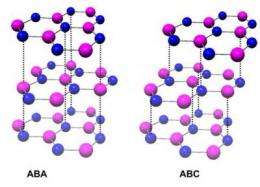How graphene's electrical properties can be tuned

An accidental discovery in a physicist's laboratory at the University of California, Riverside provides a unique route for tuning the electrical properties of graphene, nature's thinnest elastic material. This route holds great promise for replacing silicon with graphene in the microchip industry.
The researchers found that stacking up three layers of graphene, like pancakes, significantly modifies the material's electrical properties. When they fabricated trilayer graphene in the lab and measured its conductance, they found, to their surprise, that depending on how the layers were stacked some of the trilayer graphene devices were conducting while others were insulating.
"What we stumbled upon is a simple and convenient 'knob' for tuning graphene sheets' electrical properties," said Jeanie Lau, an associate professor of physics and astronomy, whose lab made the serendipitous finding.
Study results appeared online Sept. 25 in Nature Physics.
Graphene is a one-atom thick sheet of carbon atoms arranged in hexagonal rings. Bearing excellent material properties, such as high current-carrying capacity and thermal conductivity, this "wonder material" is ideally suited for creating components for semiconductor circuits and computers.
Because of the planar and chicken wire-like structure of graphene, its sheets lend themselves well to stacking in what is called 'Bernal stacking,' the stacking fashion of graphene sheets.
In a Bernal-stacked bilayer, one corner of the hexagons of the second sheet is located above the center of the hexagons of the bottom sheet. In Bernal-stacked trilayer (ABA), the top (third) sheet is exactly on top of the lowest sheet. In rhombohedral-stacked (ABC) trilayer, the top sheet is shifted by the distance of an atom, so that the top (third) sheet and the lowest sheet form a Bernal stacking as well.
"The most stable form of trilayer graphene is ABA, which behaves like a metal," Lau explained. "Amazingly, if we simply shift the entire topmost layer by the distance of a single atom, the trilayer – now with ABC or rhombohedral stacking – becomes insulating. Why this happens is not clear as yet. It could be induced by electronic interactions. We eagerly await an explanation from theorists!"
Her lab used Raman spectroscopy to examine the graphene devices' stacking orders. Next the lab plans to investigate the nature of the insulating state in ABC-stacked graphene. In this kind of stacked graphene, they also plan to study the band gap – a range in energy, critical for digital applications, in which no electrons can exist.
"The presence of the gap in ABC-stacked graphene that arises, we believe, from enhanced electronic interactions is interesting since it is not expected from theoretical calculations," Lau said. "Understanding this gap is particularly important for the major challenge of band gap engineering in graphene electronics."
Besides graphene, Lau studies nanowires and carbon nanotubes. Her research has helped physicists gain fundamental understanding of how atoms and electrons behave when they are ruled by quantum mechanics. Her lab studies novel electrical properties that arise from the quantum confinement of atoms and charges to nanoscale systems. Her research team has shown that graphene can act as an atomic-scale billiard table, with electric charges acting as billiard balls.
Her other research interests include superconductivity, thermal management and electronic transport in nanostructures, and engineering new classes of nanoscale devices.
An educational component of Lau's research effort is the active involvement of high school, undergraduate, and graduate students, especially minority and women, in her cutting-edge research, taking advantage of the ethnic diversity of UCR's student population and local communities. She is a founding faculty member of the UCR Undergraduate Research Journal. She also organized a "Women in Physics" lunch group that provides a friendly platform for female students, postdocs and faculty members to interact.
After receiving her bachelor's degree in physics from the University of Chicago in 1994, Lau proceeded to Harvard University from where she received her master's and doctoral degrees in physics in 1997 and 2001, respectively. She joined UCR in 2004, after an appointment as a research associate in the Hewlett-Packard Laboratory.
Provided by University of California - Riverside










.jpg)








